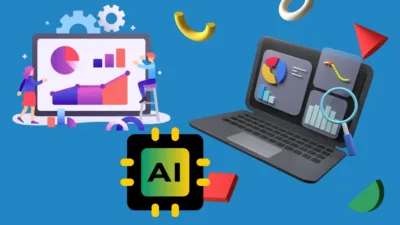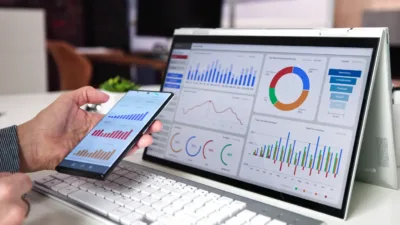Data Analytics, Data Science, and AI
In the modern tech-driven era, terms such as Data Analytics, Data Science, and Artificial Intelligence (AI) are frequently mentioned together and often misunderstood. Although these disciplines are interconnected, each serves a unique function and utilises distinct tools and techniques. Gaining clarity on how they differ is crucial for learners, working professionals, and organisations looking to harness the power of data and intelligent systems effectively.

What is Data Analytics?
Data analytics is the practice of analysing raw data to uncover useful insights that guide business decisions. It starts with gathering data, followed by organising and refining it to make it understandable. By studying this information, companies can identify trends, monitor performance, and make better choices for future actions.
Main Highlights of Data Analytics:
- Examines current and past information to understand outcomes
- Involves tools such as Power BI, Excel, SQL, and Tableau
- Focuses on explaining events and identifying reasons behind them
- Often used in business reports, dashboards, and performance tracking
Example Use Case:
An e-commerce company uses data analytics to understand which products performed best during a sale, why others didn’t sell well, and how pricing affected customer behaviour.
What is Data Science?
Data science is an advanced discipline that goes beyond basic data analysis. Itemployss sophisticated techniques, including algorithms, programming, and statistical modelling, to explore and solve complex challenges. This field brings together knowledge from mathematics, computer science, statistics, and domain-specific expertise to extract deeper insights from data and make accurate predictions.
What is Data Science?
Data science is an advanced discipline that goes beyond basic data analysis. It uses sophisticated techniques, such as algorithms, programming, and statistical modelling, to explore and solve complex challenges. This field brings together knowledge from mathematics, computer science, statistics, and domain-specific expertise to extract deeper insights from data and make accurate predictions.
Key Characteristics of Data Science:
- Applies predictive and prescriptive analytics to forecast outcomes and suggest actions
- Uses powerful tools like Python, R, Apache Spark, and Hadoop
- Frequently involves machine learning algorithms for building predictive models
- Works with both organised (structured) and disorganised (unstructured) data formats
Practical Example:
Consider a telecom company aiming to reduce customer loss. By analysing usage history, call behaviour, and support records, a data science model can forecast which users are likely to cancel their service and identify the key reasons behind it.
What is Artificial Intelligence (AI)?
Artificial Intelligence is a branch of computer science that focuses on building smart machines capable of performing tasks that typically require human intelligence. AI can learn from data, adapt to new inputs, and perform actions with minimal human intervention.
Key Features of AI:
- Enables machines to simulate human behaviour
- Includes machine learning, deep learning, NLP, and robotics
- Uses frameworks like TensorFlow, Keras, and PyTorch
- Applied in areas such as automation, image recognition, and chatbots
Example Use Case:
Voice assistants like Siri and Alexa use AI to understand voice commands, process natural language, and perform tasks like sending messages or playing music.
How Data Analytics, Data Science, and AI Differ
Although Data Analytics, Data Science, and Artificial Intelligence are closely linked, they each serve distinct purposes and rely on different tools and techniques. Data Analytics is primarily concerned with understanding past events by examining structured data using tools like Excel, SQL, and Tableau. It focuses on generating reports and dashboards that help in interpreting trends and business performance. In contrast, Data Science takes a step further by working with both structured and unstructured data to build predictive models. It uses programming languages like Python and R, along with platforms such as Spark, to automate data analysis and provide deeper insights.

Meanwhile, Artificial Intelligence aims to replicate human-like thinking and decision-making. It handles vast, often unstructured data and employs advanced methods like deep learning, robotics, and natural language processing (NLP). Tools such as TensorFlow, Keras, and OpenCV are commonly used in AI to develop intelligent systems and applications that can learn and act independently.
Where They Overlap
These three domains often work together in real-world scenarios. For example:
- Data Analytics provides the foundation by organising and cleaning the data.
- Data Science builds models that can predict future outcomes.
- AI takes it further by allowing machines to learn from those outcomes and take autonomous actions.
An online streaming platform like Netflix uses all three:
- Data analytics to track user watch history,
- Data science to recommend new shows,
- AI to personalise the homepage using real-time user behaviour.
Career Opportunities
Each field offers promising career paths:
Data Analytics Roles:
- Data Analyst
- Business Intelligence Analyst
- Reporting Analyst
Data Science Roles:
- Data Scientist
- Machine Learning Engineer
- Data Engineer
AI Roles:
- AI Researcher
- Deep Learning Engineer
- NLP Specialist
The choice depends on your skills and interests. If you enjoy interpreting charts and dashboards, data analytics may suit you. If you prefer coding and building models, data science is ideal. For those passionate about robotics, automation, and advanced algorithms, AI is the way to go.
Although Data Analytics, Data Science, and AI often work in harmony, they serve distinct purposes. Data Analytics is about understanding what has happened, Data Science is about predicting what will happen, and AI is about enabling machines to act on that information.
As industries become more data-driven, learning the nuances of these fields can help you choose the right career and contribute to innovations that shape the future. Whether you’re just starting or planning a transition, understanding these differences is the first step in the right direction.





